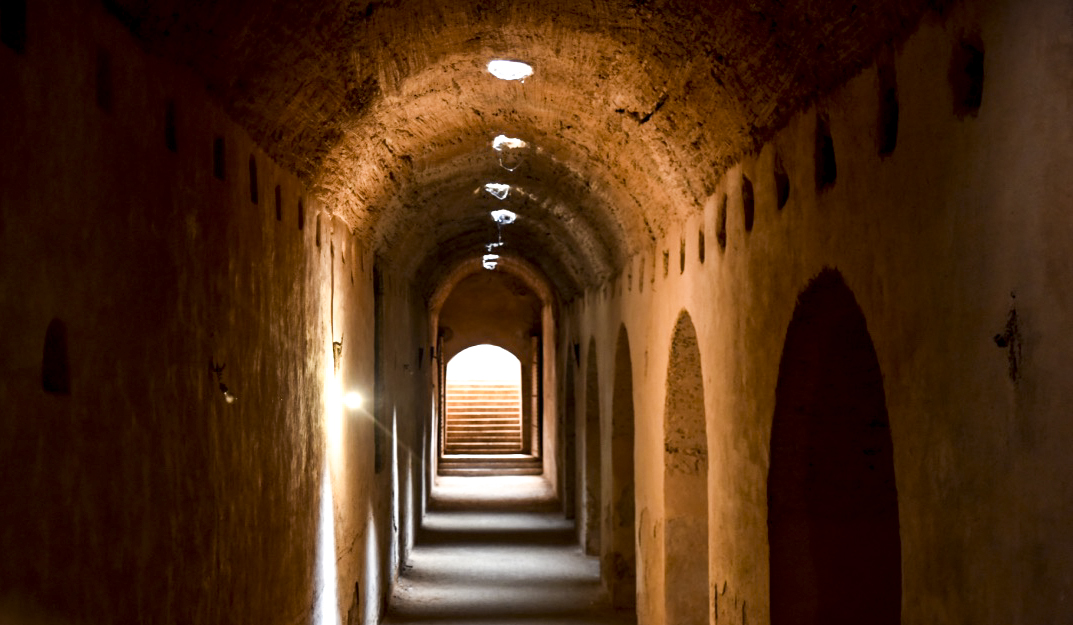The ancient part of Meknes is encircled for nearly 40 kilometers by gigantic ramparts made up of three enclosures, built during the reign of Moulay Ismail between the 17th and 18th centuries to defend the entrance of the city against invaders. The first was intended to stop the riders, the second to prevent infantry soldiers from entering the city, and the third to stop those who had managed to pass the first two obstacles.
There are three types of ramparts: those of the imperial city, the ancient city and the secondary or peripheral walls. They are made of adobe and are distinguished by their voluminous and defensive character, and constitute the military fortification of the Ismaili city. The height of these walls varies between 7 and 15 meters and their thickness varies between 1.50 and 3 meters.
The tour of the ramparts can be done either by car or by carriage. It allows to make the tour of the medina starting from the north, offering a panoramic view of the old neighborhoods and allows to appreciate the architectural richness of the buildings that continue to challenge the time…
By taking a circuit of about six kilometers, starting in general from the splendid panorama of Belle Vue (near Transatlantique Hotel), you can reach the Meriniyine street, which overlooks Oued Boufekrane and from there, along the ramparts to the north to the Berdaine gate.
A CITY OF MARVELLOUS GATES
This imposing wall has been pierced by towers, bastions and nearly 20 monumental gates, called Bab in Arabic. The doors that you can admire on the layout of the Tour of the Ramparts are indicated on the map. Below is a selection of the most beautiful doors:
Bab Mansour
Built by Sultan Moulay Ismail between 1672 and 1675 and completed by his son Moulay Abdallah in 1731. Distinguished as an architectural jewel, this door is the emblem and symbol of the city of Meknes. It is also considered as one of the most beautiful gates in the world. Sultan Moulay Ismail began the construction of the Kasbah by creating this gate to cross the fortified city walls. It is the constituent element of the oldest part of the Ismailian Kasbah. Designed according to the traditional scheme of Moroccan doors, Bab El Mansour reaches an overall height of about 16 meters. Bab Mansour Hall now houses an art gallery.
Bab Berdaine
Built in the 17th century by Moulay Ismail, this beautiful door takes its name from the manufacturers of tarpaulins that inhabited the square. In the opening, stands out the minaret of the Berdaine mosque, built by Mohammed III, then restored by Moulay Ismail.
It is the northernmost gate of the medina of Meknes. The exterior façade of this door is part of the same category of monumental doors as Bab Dar Lakbira and Bab el Khemis. It rises at the top of a hill and seems at the same time majestic and slender between its two towers.
Bab Berdaine, in the eighteenth 18th century, was to have an important role in the economy of Meknes, concentrating on it all the trade as well as diplomatic, with the North and therefore with the foreigner. It is noted that Moulay Ismail has provided this entrance to the medina with a door worthy of the royal quarters.
Bab el Khemis said « the Happy Gate »
Bab el Khemis (Thursday), one of the most beautiful Ismaili gates that does not belong directly to the edifices of the kasbah of Meknes is dated, t according to its inscription, the year 1687 (1098 of the hegira).
Monumental brick gate, delimited by two adobe square towers, was originally the west gate of «Madinat Arryad Al Anbari» (amber garden city), built during the reign of Moulay Ismail for the benefit of the Oudayas' army and the high personalities of the court.
Inscriptions engraved on its pediment said: « I am the happy door as proud as the full moon in the sky. My imposing structure tells about the glory of Sultan Moulay Ismail. He built me in 1098 (H)».
Bab Dar Lakbira (Gate of the great house)
This gate built in 1678 (1090 hegira), under the reign of Moulay Ismail, is the main monumental entrance of Dar Lakbira district which occupies a space of 320 meters long and 420 meters wide.
It is also one of the most harmonious and ancient gates of the Ismaili Kasbah. About 12 meters high, it is built entirely of brick of earth drowned in a traditional mortar made of terracota and lime.
Dar Lakbira was the first residence that Moulay Ismail had built at Meknes, after his rise to the throne in 1672, after having cleared the south-eastern part of the medina and after having also built Lahdim square.
MEKNES IN A HORSE-DRAWN CARRIAGE
Take the time to stroll in a horse-drawn carriage to discover at your own pace the historic city of Meknes. Starting from Lalla Aouda and Lahdim squares, this walk will make you discover neighborhoods and the most beautiful avenues and streets of the city. The carriages make it easy to browse the main tourist sites of the city. The time of the walk depends on the time available for the client and the cost is fixed according to the chosen circuit, the quantity of sites to visit and the number of people to transport (4 to 5 people maximum).
Several monuments benefit from the framework convention on the rehabilitation and valorization of the medina of Meknes.






















